The Porcupine's Quill
Celebrating forty years on the Main Street
of Erin Village, Wellington County
Instructor Resources
The Mysterious Death of Tom Thomson:
Study Guide
Skip to:
Source Materials
The notion of Truth in Art is one that has become increasingly timely in an era of alternative facts and fake news; a world in which philosophical rumination is conscribed by the range of 140 character tweets, albeit recently enhanced to 280 characters.
Historical Photographs
Some of the images in The Mysterious Death of Tom Thomson are based on historic photographs. In this section we will present a selection of the original photographs opposite the engravings George Walker has created from the images. In some cases the engravings replicate the detail in the photographs quite faithfully; in the case of Tom in his canoe the change in lighting makes for a dramatically different effect.
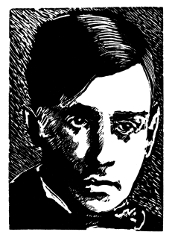
Tom had inherited a considerable sum of money from his grandfather on the occasion of his 21st birthday in 1898, and would have had no trouble affording fashionable clothes.
See the historical image upon which this engraving was based at the Library and Archives Canada website.
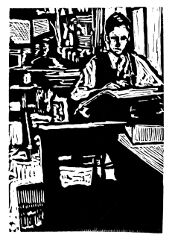
Tom started work at The Grip in December of 1908 or January, 1909 and remained with the firm until October of 1912 when he moved, with a number of his colleagues, to Rous & Mann.
See the historical image upon which this engraving was based at the Canadian Mysteries website.
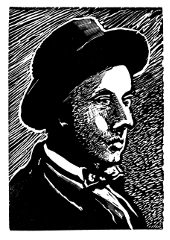
The pork pie hat, for men, was popularized by silent film star Charlie Chaplin.
The same sort of hat appears on the mysterious fisherman who watches Tom’s body being recovered by George Rowe and Laurie Dickson at the end of The Mysterious Death of Tom Thomson.
See the historical image upon which this engraving was based at the Library and Archives Canada website.
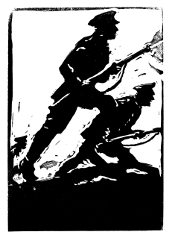
Once World War One began in earnest in July, 1914 there would have been considerable peer pressure on able-bodied men to enlist.
A smaller version of this poster appears on the wall in the recruitment office a few images further on.
See the historical image upon which this engraving was based at the Library and Archives Canada website.
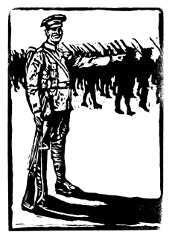
The pressure to enlist would have been relentless, particularly in the city.
Less so in the wilds of Algonquin Park.
See the historical image upon which this engraving was based at the Library and Archives Canada website.
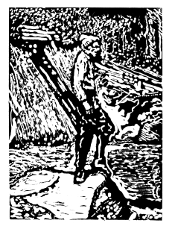
Cauchon Falls, where Little Cauchon Lake empties into Laurel Lake.
See the historical image upon which this engraving was based at the Library and Archives Canada website.
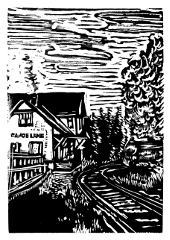
Grand Trunk train #90 eastbound from Parry Sound to Ottawa approaches Canoe Lake Station.
See the historical image upon which this engraving was based at the Canadian Mysteries website.
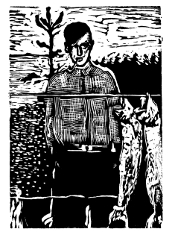
Tom summered in Algonquin Park at a time when refrigeration would have been unknown. Fish, freshly caught, or dried, would have been a staple of Tom’s diet.
Notice the shadow of the photographer in the right-hand foreground. Who is it?
See the historical image upon which this engraving was based at the Library and Archives Canada website.
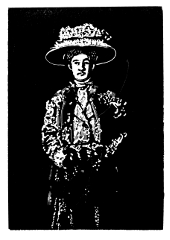
Winnifred Trainor’s parents owned a cottage on Canoe Lake in Algonquin Park.
Winnifred could have met Tom Thomson in 1912 but certainly no later than the summer of 1913.
See the historical image upon which this engraving was based at the Hutsville Doppler website.
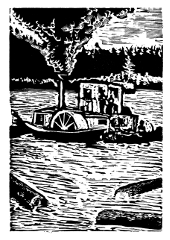
An ‘alligator’ boat of the sort that would have been in common use by the logging industry in the late 19th and early 20th centuries.
Gilmour Logging was one of the larger commercial operations in Algonquin Park. Headquartered on Canoe Lake, the company was renowned for shipping cut lumber hundreds of miles to their mill at Trenton on Lake Ontario. Mowat Lodge was originally built as a Gilmour bunkhouse.
See the historical image upon which this engraving was based at the Mysteries of Canada website.
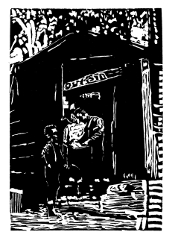
The ranger’s cabin at Achray, on Grand Lake, where Tom worked with Edward Godin through the summer of 1916. Tom painted the sign that reads ‘Out-Side-In’.
See the historical image upon which this engraving was based at the Canadian Mysteries website.
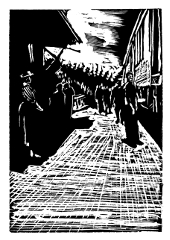
Grand Trunk train # 90 at Canoe Lake Station.
See the historical image upon which this engraving was based at the Canadian Mysteries website.
Original Artwork
Wordless novels can be effective in the classroom when used as catalysts to teach skills of observation and comprehension, analysis, order and sequencing and hence the sort of visual assessment that often leads to creativity. In The Mysterious Death of Tom Thomson a number of the woodblock images are based on iconic paintings, though the source of the images may not be apparent to the casual reader. This is, very possibly, George Walker’s intent: to deliberately meld the distinction between the landscape of Algonquin Park and the paintings of Tom Thomson to the point at which the two become indistinguishable. Page 79, for example, is sourced from Pine Trees at Sunset; p 101, Northern River, 1915; p 123, Byng Inlet; p 125, Round Lake, Mud Bay; p 135, The Jack Pine; and it is surely no coincidence that the image on page 139 is based on The West Wind, which was found, perhaps unfinished, on Tom Thomson’s easel after his death.
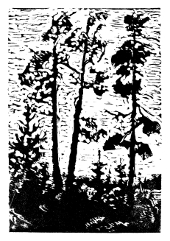
Pine Trees at Sunset (1915). The seamless transition in the sky from a strangely acidic green to tangerine orange is technically diffcult to achieve with oils, particularly given that the image was likely painted quickly, in less than 30 minutes. The painting set a price benchmark when it sold at auction in 2008 for just under $2 million.
See the Tom Thomson painting upon which this engraving was based at the Tom Thomson Catalogue Raisonné website.
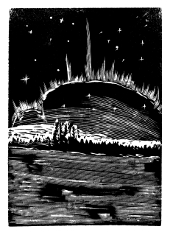
Northern Lights, Fall 1915. Thomson was often enchanted by the mystery he found in the night, when the pale light of the moon and stars glistened on the surface of a lake and underscored the forbidding majesty of the surrounding forest. These commonplace phenomena formed an essential part of what Tom’s patron James MacCallum has called his ‘Encyclopedia of the North’.
George Walker has furthered this nocturnal theme in his moonlit rendition of the period photograph of Tom in his canoe (page 165).
See the Tom Thomson painting upon which this engraving was based at the Tom Thomson Catalogue Raisonné website.
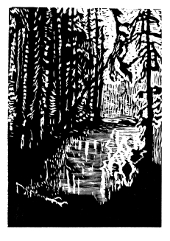
Northern River, 1915. Writing to James MacCallum, Thomson characterized Northern River as his ‘swamp picture’, which hardly does justice to the masterful composition that has been recognized as Thomson’s first major artistic triumph. As with many of his paintings, the scene is common in Algonquin Park and would be unremarkable if not for the intensity of concentration brought into play by the artist.
See the Tom Thomson painting upon which this engraving was based at the National Gallery of Canada website.
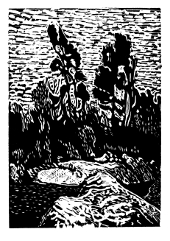
Byng Inlet (1914–15). The trees in this painting are eastern white pines, which often reach the age of 250 years, and occasionally survive longer in spite of their favoured proximity to monumental outcrops of precambrian rock as pictured here on the eastern shore of Georgian Bay. Byng Inlet is south-west of the village of Britt, between Parry Sound and Sudbury, close to the mouth of the Magnetawan River which connects Algonquin Park to Georgian Bay. Tom Thomson sketched in this area just the one summer, in 1914, on his way to James MacCallum’s cottage at Go Home Bay.
See the Tom Thomson painting upon which this engraving was based at the Tom Thomson Catalogue Raisonné website.
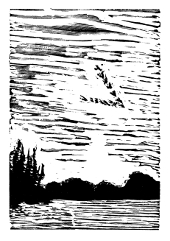
Round Lake, Mud Bay (1915). Curator Joan Murray has documented an inscription on the back of Round Lake that claims the flock of geese is headed south. If that information is, in fact, correct (?) then the artist must have been facing east, which means we are looking at a sunrise, which is somewhat doubtful because of the slightly reddish cast to the yellow at the bottom left.
Any number of commentators have remarked on the strength of Thomson’s sunsets, which may have been enhanced by the eruption of Lassen Peak in northern California in May of 1915. The volcano spewed ash 30,000 feet into the atmosphere, some of which may well have been pushed far to the east by the prevailing jet stream.
See the Tom Thomson painting upon which this engraving was based at the Art Gallery of Ontario website.
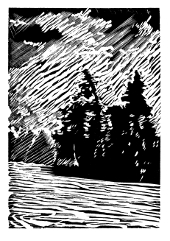
Black Spruce in Autumn (Fall, 1915). There are a number of visual effects that recur frequently enough in Thomson’s paintings that together they can be characterized as essential to his unique visual grammar. One is the theme of the ‘far shore’ that Joyce Wieland explored in her 1976 film of the same name, but notice that the ‘far’ shore (as depicted in Black Spruce in Autumn, for example) is never so very far distant that it couldn’t be reached in a vigorous twenty-minute paddle. Another, related, visual effect is that Thomson’s perspective is almost always that of a canoeist, who sees what he sees from an elevation of four feet above the waterline, which tends to accentuate the height of trees, especially those in the foreground, and by so doing accords them a majesty they might otherwise lack.
See the Tom Thomson painting upon which this engraving was based at the Tom Thomson Catalogue Raisonné website.
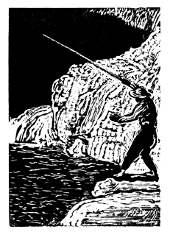
The Fisherman (Winter, 1916). One of a group of paintings done at this same time that share a certain ‘staged’ quality and a stiffness of configuration that persuaded James MacCallum to suggest they may have been unfinished. In either case The Fisherman is nowhere near as compelling as either The Jack Pine or The West Wind, both of which were painted shortly thereafter. It is conceivable The Fisherman may be referenced in The Mysterious Death of Tom Thomson for no other reason than to prefigure the artistic conceit by which George Walker introduces into the narrative his own mysterious fisherman, wearing a remarkably similar hat, on page 199.
See the Tom Thomson painting upon which this engraving was based at the Tom Thomson Catalogue Raisonné website.
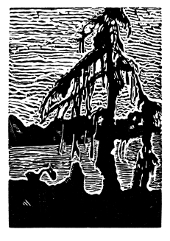
The Jack Pine (1917). Tom Thomson was known as a colorist who was particularly skilled at mixing colours to achieve unexpected and remarkable effects. The plum colour on the rock in the foreground is one such example, particularly in contrast to the pale blues on the far shore. Thomson’s dramatic use of specimen trees as the central architectural element in his paintings was yet another visual effect that serves to characterize his work, and to differentiate it from the more ‘civilized’ oaks and maples that were painted by Thomson’s contemporary, Homer Watson, whose landscapes were set in the relative gentility of the Grand River Valley near Kitchener.
See the Tom Thomson painting upon which this engraving was based at the National Gallery of Canada website.
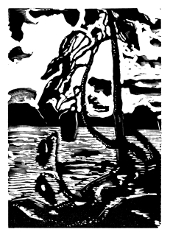
The West Wind (1917). Painted in the winter of 1916–17, this iconic pine demonstrates that Thomson’s formative artistic influences were at once eccentric and wholly original. Here he combines the sinuous forms of Art Nouveau (a style he had used to considerable effect in earlier paintings such as Northern River), with the vivid colours of the early Expressionists, and melds the two to create a reflection of Canada that had never before been seen. Arthur Lismer has suggested that he saw in this painting a paradigm of what he imagined as the essence of the Canadian character—strength and determination in the face of adversity.
See the Tom Thomson painting upon which this engraving was based at the Art Gallery of Ontario website.
Exercise
Historical Photographs
Choose an image from the preceding selection and answer the following questions. Refer to the chronology, references and your own research in your answer.
- Who are the people and/or what are the places depicted in the image?
- What clues does the image give us about the time in which the story takes place?
- What does the image suggest about life in that era?
- What purpose does the image serve in furthering the narrative?
Original Artwork
- Has George Walker done an effective job in rendering what in many cases are large format oil paintings to relatively miniscule engravings? Why do you or don’t you think so?
- Can the recognizable essential form of the original painting be presented without the use of colour? Why or why not?
- Is George Walker’s choice of wood engraving as the medium appropriate to a story about the Canadian back country? Explain your answer.
This Study Guide is available as a free download in Pdf format to anyone interested in using it as an aid to teaching George A. Walker's The Mysterious Death of Tom Thomson (2012). The Guide may not be copied and offered for sale by any third party. This Study Guide is produced with the support of the Ontario Media Development Corporation and the Ontario Ministry of Education.

The Porcupine's Quill would like to acknowledge the support of the Ontario Arts Council and the Canada Council for the Arts for our publishing program. The financial support of the Government of Canada through the Canada Book Fund (CBF) is also gratefully acknowledged.
The Mysterious Death of Tom Thomson:
- Introduction
- Who Is Tom Thomson?
- Visual Literacy
- Source Materials
- Theories & Hypotheses
- Master Class
- Appendix A: Glossary of People & Places
- Appendix B: Chronology of Events
- Download the Study Guide